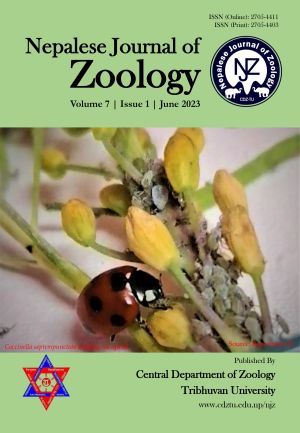Prevalence of gastrointestinal parasites among primary school children in Bhaktapur, Nepal
DOI:
https://doi.org/10.3126/njz.v7i1.56307Keywords:
Bhaktapur, Gastrointestinal parasites, Prevalence, School childrenAbstract
Gastrointestinal parasitic infections are the most common and persistent infections caused by helminths and protozoa mainly in developing countries like Nepal. The present study was conducted from September 2019 to June 2020 to find out the prevalence of gastrointestinal parasites among primary school children in Bhaktapur District, Nepal. A total of 190 stool samples were collected and examined microscopically by the sedimentation technique and the floatation technique. The overall prevalence was found to be 16.84%. The prevalence was significantly higher (p<0.05) among students in public schools (29.23%) than in private schools (10.40%). Similarly, higher prevalence was found among boys (19.27%) in the sex-wise study, Muslim (33.33%) students than others and among vegetarian (30%) students. The source of drinking water and parents’ education and occupation were also found to be factors affecting the rate of prevalence of gastrointestinal parasites (GIPs). The study revealed eight different types of GIPs (Ascaris lumbricoides, Entamoeba coli, Entamoeba histolytica, Enterobius vermicularis, Giardia lamblia, Ancylostoma duodenale, Schistosoma mansoni, and Taenia solium). Among them, Giardia lamblia (55.55%) was the most dominant species. Efforts should be focused on improving the efficacy of administering anthelminthic drugs.
Downloads
Downloads
Published
How to Cite
Issue
Section
License

This work is licensed under a Creative Commons Attribution-NonCommercial 4.0 International License.
This license enables reusers to distribute, remix, adapt, and build upon the material in any medium or format for noncommercial purposes only, and only so long as attribution is given to the creator.

